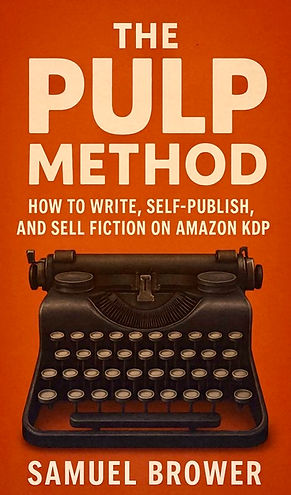
The Pulp Method
60,000 Word Novel - Blank Outline
ACT ONE: The Ordinary World
Chapter 1 – Opening Image / Hook
Suck them in with something super exciting and provocative. Doesn’t necessarily have to be in the wheelhouse of the story, but it needs to be related.
Chapter 2 – The Hero’s World
Show the everyday life, relationships, goals, and flaws of the protagonist. Establish the status quo.
Chapter 3 – Theme Stated
A character (often a side character) states the story’s core theme or moral question.
Chapter 4 – Set-Up of Stakes
Clarify what the protagonist wants, what’s in the way, and what’s at stake.
Chapter 5 – Inciting Incident / Call to Adventure
An unexpected event disrupts the ordinary world and kicks off the journey.
Chapter 6 – Debate / Refusal of the Call
The hero hesitates or outright refuses the journey. Doubt, fear, or external pressure take hold.
Chapter 7 – Break Into Act Two / Crossing the Threshold
The hero accepts the call to adventure and enters a new, unfamiliar world.
ACT TWO-A: The New World
Chapter 8 – B Story Begins
A subplot starts, often involving romance, friendship, or a mentor. It explores the theme emotionally.
Chapter 9 – Fun and Games / Trials Begin
This is the heart of the premise—early successes or failures in the new world. Show the hero learning.
Chapter 10 – Tests, Allies, Enemies
New characters enter the story. Introduce allies, rivals, and villains. Loyalties form or clash.
Chapter 11 – First Mini-Victory
The hero experiences success. False confidence or achievement. Raises stakes.
Chapter 12 – Deeper Challenges
Complications arise. The hero starts to struggle. The world reveals its teeth.
Chapter 13 – Midpoint: False Victory or Revelation
A major event changes everything. Often a success that feels hollow or a devastating truth.
Chapter 14 – Fallout from the Midpoint
New information or failure triggers internal and external consequences.
Chapter 15 – Inner Doubt & Cost
The hero begins to question their beliefs, choices, and identity. Emotional consequences grow.
Chapter 16 – Commitment Deepens
Despite doubt, the hero doubles down. Growth begins.
Chapter 17 – Enemy Strengthens / Secrets Revealed
The antagonist shows their full threat. Secrets and betrayals emerge.
ACT TWO-B: Descent & Preparation
Chapter 18 – Bad Guys Close In
The hero faces mounting opposition. Tension and danger rise on all fronts.
Chapter 19 – Crisis / All Is Lost
A major loss, betrayal, or failure devastates the hero. Hope seems gone.
Chapter 20 – Dark Night of the Soul
The hero wrestles with despair. Deep reflection, guilt, or a moment of surrender.
Chapter 21 – Atonement with Self / Mentor
The hero finds clarity or is offered wisdom. Often reconnects with mentor, higher self, or core truth.
Chapter 22 – Break Into Act Three / Return with the Elixir
The hero rises with renewed strength, insight, or plan. Begins the final push.
ACT THREE: The Final Conflict
Chapter 23 – Final Preparation
Gather allies, weapons, or wisdom. Prepare for the climax.
Chapter 24 – Approach the Inmost Cave
Enter the heart of danger. Final obstacle looms. The stakes are life-altering.
Chapter 25 – Climactic Battle Begins
The final confrontation begins—against the villain, system, or self.
Chapter 26 – Sacrifice / Transformation
The hero must give something up—belief, person, identity—to win.
Chapter 27 – Final Victory / Resolution
The hero wins—but because of transformation, not strength alone.
Chapter 28 – Return to the Ordinary World
The hero returns to where they began, but they are changed.
Chapter 29 – Closing Image (Mirror of Opening)
Reflect the transformation. The story ends with an echo or contrast to the opening image.
Chapter 30 – Denouement / Future Glimpse
Wrap up loose threads, hint at the future, or leave on a note of hope or finality.
8,000 Word Short Story – Blank Outline
1. Hook / Opening Image (Setup + Theme Intro)
-
Open in motion or tension — a moment that immediately grabs attention.
-
Introduce protagonist and hint at what’s missing, broken, or about to change.
2. Inciting Incident (Disruption)
-
A choice, challenge, or change pulls the protagonist out of their norm.
-
Stakes or desires become clear.
3. Refusal / Resistance / Rising Tension
-
The protagonist hesitates, reacts emotionally, or chooses badly.
-
They may try to avoid the problem, but something forces escalation.
4. Turning Point / Midpoint Shift
-
A major revelation or complication changes the direction of the story.
-
Stakes increase. The protagonist starts to see what’s really at play.
5. Crisis / All Is Lost
-
The protagonist fails, loses something, or faces emotional defeat.
-
Often mirrors the flaw shown in the opening.
6. Transformation / Realization
-
The character makes a key internal change (understands a truth, lets go of fear, etc.).
-
This moment of growth allows for a different choice.
7. Climax / Final Choice or Action
-
The protagonist takes decisive action that resolves the external conflict.
-
Often a mirror opposite of their earlier hesitation or mistake.
8. Resolution / Closing Image
-
A brief scene showing the new status quo, with the character changed.
-
Close with a callback to the opening or a final emotional beat.









